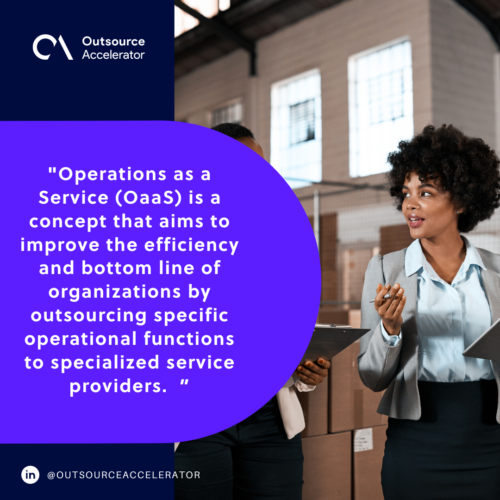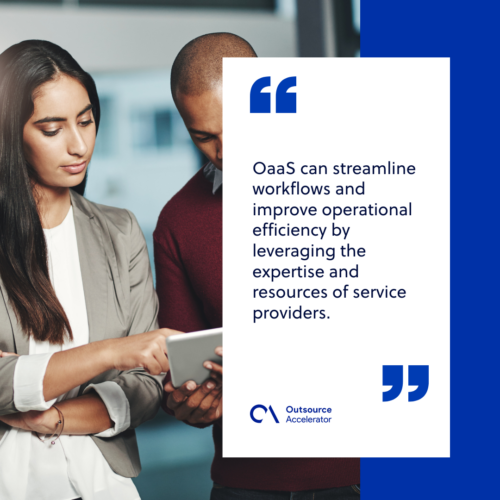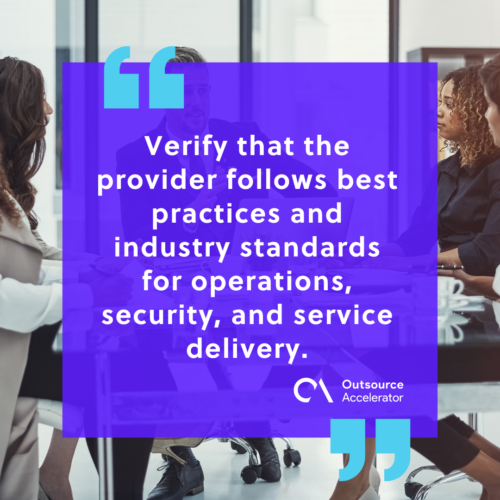Operations as a Service and its impact on business

The demand for efficiency and agility has never been higher as the bar for business growth rises. There are many ways for companies to approach their operations, and Operations as a Service (OaaS) is one of them.
Imagine having the ability to streamline operations, cut costs, and scale effortlessly—all while focusing on your core strengths.
OaaS leverages cutting-edge technology to offload mundane yet critical tasks, enabling businesses to thrive in an increasingly competitive environment.
In this article, we delve into the world of OaaS to understand its significance, explore its impact on business operations, and discuss the opportunities and challenges that come with its adoption.
What is Operations as a Service (OaaS)?
Operations as a Service (OaaS) is a concept that aims to improve the efficiency and bottom line of organizations by outsourcing specific operational functions to specialized service providers.
Just like Platform as a Service (PaaS) and Infrastructure as a Service (IaaS), OaaS allows businesses to offload certain operational responsibilities to third-party experts. This enables them to focus on core activities and strategic objectives.
Essentially, OaaS turns various operational functions into a service that can be accessed on-demand, much like traditional utilities. This facilitates greater flexibility and adaptability in the ever-changing business environment.

Key components of Operations as a Service
Each OaaS component plays a crucial role in delivering the efficiency, scalability, and flexibility that the service offers.
The key components of OaaS include:
Cloud infrastructure
Cloud infrastructure forms the backbone of OaaS, providing the necessary computational power, storage, and network resources on demand.
Cloud platforms enable businesses to access and utilize these resources from their own hardware and software.
Security and compliance are heavily emphasized in cloud infrastructure. Providers offer advanced security measures, including encryption, multi-factor authentication, and regular security audits, to protect sensitive data.
Additionally, they ensure compliance with industry standards and regulations, such as GDPR, HIPAA, and ISO standards. Businesses have peace of mind regarding their data integrity and legal obligations.
Automation and AI
Automation tools are integral to OaaS. They automate repetitive and time-consuming tasks such as data entry, system monitoring, and routine maintenance.
This reduces the likelihood of human error and frees up employees to focus on more strategic activities. Tools like Robotic Process Automation (RPA) can handle high-volume, rule-based tasks efficiently.
Artificial Intelligence (AI) enhances OaaS by providing intelligent insights and automating complex decision-making processes. AI algorithms can analyze vast amounts of data to identify patterns, predict trends, and recommend actions.
This capability is particularly valuable in areas like predictive maintenance, customer service (through chatbots and virtual assistants), and supply chain optimization.
Managed services
Managed services involve outsourcing various non-core business functions to third-party providers.
By leveraging managed services, businesses can access specialized expertise and ensure that these functions are handled efficiently and professionally.
Some examples of managed services include:
- IT support and maintenance. Managed IT services provide round-the-clock monitoring, support, and maintenance of IT infrastructure, ensuring system uptime and performance.
- Cybersecurity. Managed security services offer protection against cyber threats through continuous monitoring, threat detection, and response.
- Human Resources. HR-managed services handle recruitment, payroll, benefits administration, and compliance, allowing businesses to focus on their core operations.
- Finance and accounting. Outsourcing finance and accounting functions can help businesses manage their financial operations, including bookkeeping, tax compliance, and financial reporting, with greater accuracy and efficiency.
Benefits of Operations as a Service on business processes
Operations as a Service (OaaS) offers numerous benefits that can significantly enhance business processes.
Here’s a detailed look at each:
Cost savings
Outsourcing operational functions through Operations as a Service can lead to significant cost savings for businesses.
By partnering with specialized service providers, companies can avoid several common expenses. These are usually associated with hiring and training in-house staff, acquiring and maintaining equipment, and managing operational processes.
With OaaS, businesses pay only for the services they use, allowing for more accurate budgeting and financial planning. This model provides financial flexibility and helps companies avoid overprovisioning resources.
Efficiency and streamlined processes
OaaS can streamline workflows and improve operational efficiency by leveraging the expertise and resources of service providers.
These providers are specialized in their respective areas, allowing them to optimize processes, automate tasks, and implement best practices.
By outsourcing operational functions, businesses can benefit from increased productivity, faster turnaround times, and smoother workflows.
OaaS also facilitates the quick implementation of new technologies and solutions, enabling businesses to respond swiftly to market opportunities and challenges. This rapid deployment reduces time-to-market and enhances competitive positioning.
With OaaS, businesses have access to the latest tools and technologies, driving continuous improvement and innovation. OaaS providers often incorporate best practices and industry standards, ensuring that operations remain efficient and up-to-date.

Focus on core business activities
By outsourcing non-core operational functions to OaaS providers, businesses can free up resources and personnel to focus on strategic initiatives and core business activities.
This shift in focus can enhance innovation, drive growth, and improve overall competitiveness in the market. OaaS allows organizations to delegate routine tasks and operational responsibilities, enabling them to allocate resources more effectively.
Scalability and flexibility
OaaS enables businesses to scale their operations up or down quickly based on their needs.
This flexibility is crucial for managing seasonal fluctuations, responding to market changes, and supporting business growth without the constraints of traditional infrastructure.
As business requirements evolve, OaaS providers can rapidly adjust the level and scope of services provided. This adaptability ensures that businesses can maintain optimal performance and efficiency without significant delays or disruptions.
Access to specialized expertise
OaaS provides businesses with access to specialized expertise and industry best practices that may not be available in-house.
Service providers are extremely knowledgeable and experienced. Businesses benefit from the latest technologies, tools, and strategies in their operations.
This access to expertise can drive innovation, improve decision-making, and enhance the overall quality of operational processes.
How to implement Operations as a Service
Implementing Operations as a Service involves several key steps and careful considerations to ensure a smooth transition and maximize the benefits.
Here’s a guide on how to implement OaaS and the important factors to consider:
1. Identify operational pain points
Begin by conducting a thorough assessment of your current operations to identify areas that are inefficient, costly, or require specialized expertise. This will help determine which functions are best suited for OaaS.
2. Set clear objectives
Define what you aim to achieve with OaaS, such as cost reduction, increased scalability, improved focus on core activities, or enhanced innovation. The implementation process will be guided by these specific goals, which will also help gauge progress.
3. Criteria for selection
Evaluate potential OaaS providers based on factors such as:
- Their expertise
- Track record
- Service offerings
- Security measures
- Compliance with industry standards, and
- Customer support
Look for providers that align with your business needs and objectives.
4. Evaluate provider capabilities
Assess the providers’ technological capabilities, scalability options, and flexibility. Ensure they can integrate seamlessly with your existing systems and support your specific operational requirements.
5. Planning and execution
Create a detailed plan for transitioning to OaaS, including timelines, resource allocation, and risk management.
Ensure all stakeholders are involved in the planning process to address potential concerns and gain buy-in.
6. Manage change and minimize disruption
Implement change management practices to help employees adapt to new processes and technologies. Provide training and support to ensure a smooth transition and minimize operational disruptions.
7. Data security concerns
Outsourcing operations to a third party involves handling sensitive data. Ensure the OaaS provider has robust security measures in place, including encryption, access controls, and regular security audits.
8. Dependency on service providers
Relying on external providers for critical operations can introduce risks. Mitigate this by having clear service level agreements (SLAs), contingency plans, and regular performance reviews with the provider.
9. Navigate legal requirements
Ensure that the OaaS provider complies with all relevant laws and regulations specific to your industry. This includes data protection regulations such as GDPR, HIPAA, and other local or international standards.
10. Ensure compliance with industry standards
Verify that the provider follows best practices and industry standards for operations, security, and service delivery. This ensures that your business remains compliant and minimizes regulatory risks.

11. Address employee concerns
Employees may have concerns about job security and changes in their roles. Communicate transparently about the benefits of OaaS, how it will impact their work, and the support available to them.
12. Promote a culture of adaptability
Foster a culture that embraces change and innovation. Encourage continuous learning and provide opportunities for employees to develop new skills that align with the OaaS model.
5 Evolving trends in Operations as a Service
Operations as a Service is a rapidly evolving concept that continues to transform the way organizations handle their operational functions.
Here are some key trends that are shaping the future of OaaS:
Trend #1: Artificial Intelligence (AI) and Machine Learning (ML)
OaaS providers are increasingly leveraging AI and ML technologies to automate operational tasks and improve overall efficiency.
These tools are capable of analyzing vast volumes of data and producing insightful results. This allows organizations to make more informed decisions and optimize operational processes.
Trend #2: Internet of Things (IoT)
OaaS providers are beginning to incorporate IoT technologies into their offerings, enabling organizations to monitor and control their operations in real time.
IoT-enabled sensors and devices can collect data on operational processes, providing valuable insights and identifying areas for improvement.
Trend #3: Blockchain technology
OaaS providers are increasingly adopting blockchain technology to secure and streamline transactions between businesses and service providers.
The technology can provide secure and transparent records of transactions, ensuring greater transparency and accountability between parties.
Trend #4: Cloud computing
With the growth in cloud-based infrastructure, OaaS providers are taking advantage of cloud technology to offer scalable and flexible solutions to their clients.
Cloud computing allows service providers to customize services to meet specific client needs easily. It also enables organizations to access OaaS solutions from anywhere with an internet connection.
Trend #5: Virtual and Augmented Reality (VR/AR)
Virtual and augmented reality technologies are being incorporated into OaaS solutions to offer businesses immersive experiences.
For example, VR/AR-enabled training and simulations can help organizations improve their workflows and productivity.







 Independent
Independent




